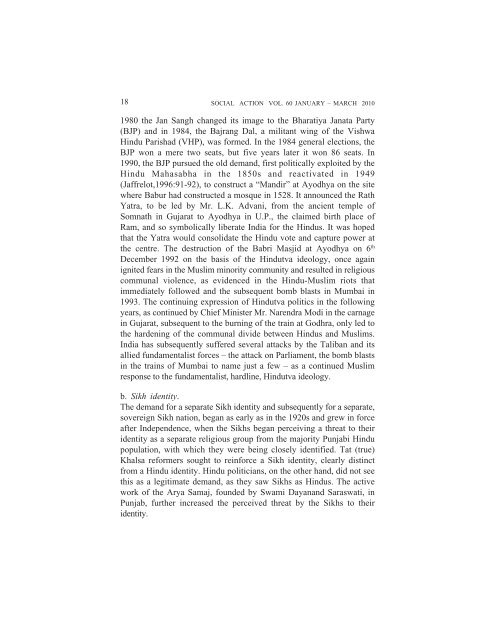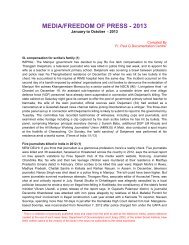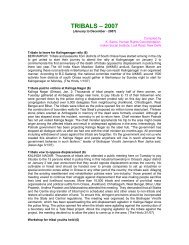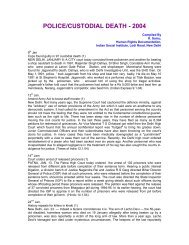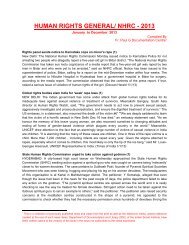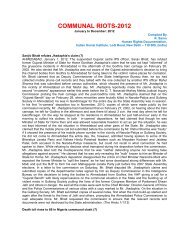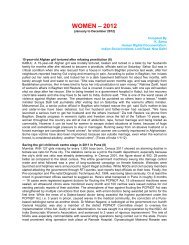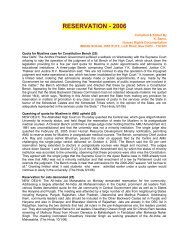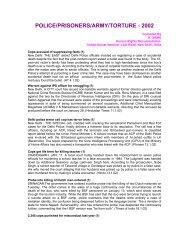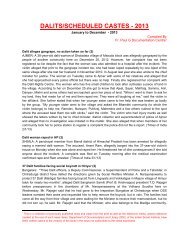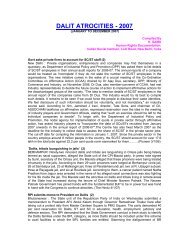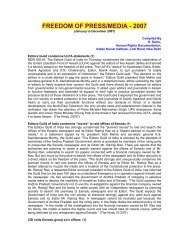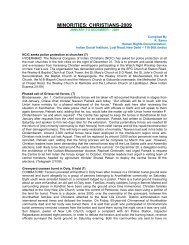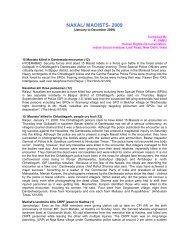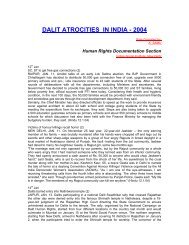Communal Violence and Assertion of Identity - Indian Social Institute
Communal Violence and Assertion of Identity - Indian Social Institute
Communal Violence and Assertion of Identity - Indian Social Institute
You also want an ePaper? Increase the reach of your titles
YUMPU automatically turns print PDFs into web optimized ePapers that Google loves.
18<br />
SOCIAL ACTION VOL. 60 JANUARY – MARCH 2010<br />
1980 the Jan Sangh changed its image to the Bharatiya Janata Party<br />
(BJP) <strong>and</strong> in 1984, the Bajrang Dal, a militant wing <strong>of</strong> the Vishwa<br />
Hindu Parishad (VHP), was formed. In the 1984 general elections, the<br />
BJP won a mere two seats, but five years later it won 86 seats. In<br />
1990, the BJP pursued the old dem<strong>and</strong>, first politically exploited by the<br />
Hindu Mahasabha in the 1850s <strong>and</strong> reactivated in 1949<br />
(Jaffrelot,1996:91-92), to construct a “M<strong>and</strong>ir” at Ayodhya on the site<br />
where Babur had constructed a mosque in 1528. It announced the Rath<br />
Yatra, to be led by Mr. L.K. Advani, from the ancient temple <strong>of</strong><br />
Somnath in Gujarat to Ayodhya in U.P., the claimed birth place <strong>of</strong><br />
Ram, <strong>and</strong> so symbolically liberate India for the Hindus. It was hoped<br />
that the Yatra would consolidate the Hindu vote <strong>and</strong> capture power at<br />
the centre. The destruction <strong>of</strong> the Babri Masjid at Ayodhya on 6 th<br />
December 1992 on the basis <strong>of</strong> the Hindutva ideology, once again<br />
ignited fears in the Muslim minority community <strong>and</strong> resulted in religious<br />
communal violence, as evidenced in the Hindu-Muslim riots that<br />
immediately followed <strong>and</strong> the subsequent bomb blasts in Mumbai in<br />
1993. The continuing expression <strong>of</strong> Hindutva politics in the following<br />
years, as continued by Chief Minister Mr. Narendra Modi in the carnage<br />
in Gujarat, subsequent to the burning <strong>of</strong> the train at Godhra, only led to<br />
the hardening <strong>of</strong> the communal divide between Hindus <strong>and</strong> Muslims.<br />
India has subsequently suffered several attacks by the Taliban <strong>and</strong> its<br />
allied fundamentalist forces – the attack on Parliament, the bomb blasts<br />
in the trains <strong>of</strong> Mumbai to name just a few – as a continued Muslim<br />
response to the fundamentalist, hardline, Hindutva ideology.<br />
b. Sikh identity.<br />
The dem<strong>and</strong> for a separate Sikh identity <strong>and</strong> subsequently for a separate,<br />
sovereign Sikh nation, began as early as in the 1920s <strong>and</strong> grew in force<br />
after Independence, when the Sikhs began perceiving a threat to their<br />
identity as a separate religious group from the majority Punjabi Hindu<br />
population, with which they were being closely identified. Tat (true)<br />
Khalsa reformers sought to reinforce a Sikh identity, clearly distinct<br />
from a Hindu identity. Hindu politicians, on the other h<strong>and</strong>, did not see<br />
this as a legitimate dem<strong>and</strong>, as they saw Sikhs as Hindus. The active<br />
work <strong>of</strong> the Arya Samaj, founded by Swami Dayan<strong>and</strong> Saraswati, in<br />
Punjab, further increased the perceived threat by the Sikhs to their<br />
identity.


